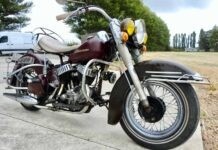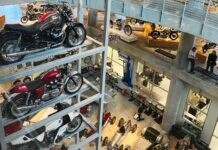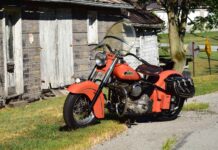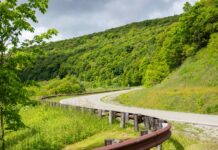The song, Mamas Don’t Let Your Babies Grow Up to Be Cowboys took on new meaning as this writer listened intently to a recent interviewee. It became very clear to me just how much influence mamas have on the futures of their offspring. Motorcycle enthusiast Mike Kane related how his life had turned into collecting, reconstructing and loving motorcycles passionately. The reason: His mother had forbidden him from having a motorcycle throughout his youth! At the ripe old age of 18, free of parental chains, he purchased his very first motorcycle. As it turned out, one week later he had his mother riding on the passenger seat! That was the beginning of a lifelong relationship with his first love; now 40 years later, he still falls asleep dreaming of which motorcycle he will work on the next day—and what he will create in the process.

Thanks to Kane’s mother, a piano and organ teacher, his relationship with Harley-Davidsons began at her studio because one of her students had a Harley. “I rode over to her house on my chopper and talked with the guy. He had a completely stock 1941 Harley and he wanted to sell it. After seeing the bike at his house I wanted it, but didn’t have enough money. He told me to save up and come back when I had enough.” Kane saved the money, purchased the bike in 1973 and later, after completely restoring it, painted the name “Virginia Lee,” his mother’s name, on the gas tank. The bike remains in his private collection to this day. Another bike in his collection, a 1947 Knucklehead, has “Mama tried” inscribed on the gas tank!
Kane’s creative ability first came to my attention at a housewarming for his newly constructed shop adjacent to his newly constructed home, all of which he designed and built. The shop, 2,000 square feet with a 16-foot high ceiling, is accessed through his living room. Among the walls of high-tech tools and motorcycle parts, several motorcycles in various stages of reconstruction, repair and disrepair sit waiting for attention, while his current piece of art, a 1923 ACE, juts up from the floor on a pneumatic work lift. Pictures of antique motorcycles, photographed from various angles, adorn the walls of the shop as if they were pin-ups of old movie stars. The décor in the interior of the home consists of motorcycle artwork, antique motorcycles in each room and mountains of motorcycle “stuff” (stuff is a word Mike uses creatively, and often, when referring to his work) that Kane collects while searching the junkyards, yard sales and the Internet for parts. Tastefully decorated, one feels as if they are taking a walk in a historic motorcycle museum.

When asked how he first got started into motorcycle restoration, Kane’s answer was simple. “When you’re a young kid with no money, you have to fix stuff yourself because you can’t afford to take it to a shop. In those years, it was easy to take things apart to see how they worked, and then put them back the same way, or with new parts. At that time, a ‘chip’ to me wasn’t the ignition module; it was a mark on the paint! So I learned how a motor worked and how to fix them. I learned that the more I rode them, the more I could actually ‘feel’ how they worked. You don’t look at the speedometer to see how fast you are going; you ‘feel’ how fast you are going. If the motor isn’t running right you ‘feel’ it; it’s all feeling for me, and that’s all from doing the work. It’s not a hobby to me; it’s a passion. Instead of watching TV, I played with bikes and on weekends I worked on them.”
Kane makes it his business to know if something isn’t correct on a previously restored bike. “I’ve been studying bikes for 40 years through books and people who own them (always more than one person because one person could be wrong). I don’t look at other people’s restorations for my information. I look for original pictures and copy from there.” Kane actually takes a magnifying glass and pores over pictures to figure out exactly how they are supposed to be constructed. Through his years of experience he has developed friendships with collectors all over the world. Often, if he needs to make a part to reconstruct a motorcycle exactly, he will borrow the part from one of his contacts, copy it precisely, and then return the borrowed piece. “I do the same thing for friends—I loan them stuff and they copy it and return it to me.”

When asked what enjoyment comes from the work, Kane explained that he enjoys just bringing something back that’s dead and forgotten. “It’s very satisfying to take something from nothing and finish it the way it came off the factory in, say, the 1920s, and ride it down the road. And when you ride it, you know every little piece in the wheel, the motor and the gas tank. If something happens, you can feel it coming; you feel like you are one with the bike, you know them that well—it’s right between your legs—they might act up, but they don’t talk back!”
Kane rides all of his bikes after restoring them. “People love to see old stuff,” he says. One day, while riding his Henderson to the local motorcycle hangout in Cave Creek, he met Larry, another collector. They became friends. Larry saw some of Kane’s work and asked him to restore a 1923 ACE motorcycle that he had purchased in 1984 from an estate auction of the late Steve McQueen who had ridden the bike and also collected, and worked on, antique motorcycles. According to Kane, the ACE, with its low and sleek

design, was a real flamboyant, racy and very fast motorcycle in the 1920s. Larry hung on to the bike for years, but really didn’t put any effort into restoring it correctly. Kane set to work, finding missing parts and ended up locating a generator, making a generator bracket, finding a horn and making a horn bracket, rebuilding the speedometer, and putting on a speedometer drive and cable. It needed a battery box, a chain guard—all items he borrowed, copied, and made with the purpose of remaking it exactly the way it was in the 1920s. “I really only have a month’s worth of time into the bike, but much of the process is in the time locating parts and waiting for them to arrive. Nearly finished at this writing, Kane plans to ride the bike before Larry gets it back—and if he has anything to do with it, Larry will ride it, also!

Kane only works on American bikes, although he doesn’t have anything against foreign bikes. “That’s just not my deal—I like doing different projects and I love the challenge the first time I do it. The second and third time it becomes ‘work’ and not so much ‘fun’—that’s why I like to do a ‘crusteration’ every once in a while.” Sitting off to the side is a 1948 Harley that looks like it’s just been dragged out of a barn. “I have it running; it looks very old and I will leave it like that, but everything you can’t see on it will be brand new—like the wheel bearings, the engine, the transmission; everything will work great, but the look will be old and crusty!” Kane plans to change the motor from a Flathead to a Panhead because he already has a Flathead bike. “This will just be for my fun stuff to ride around, unless someone talks me out of it. I’m just always looking for bikes to do; I get a lot of interest from people who approach me, say they’ve got something, and I encourage them to get it going and ride it. If I had a goal, I’d say I would like to meet more guys that want to get their bikes restored to be ridden—not just sit in the living room.”

Kane’s days and nights are devoted to his love of bikes and working on them. “I can hardly wait to get started. I spend about an hour each morning looking for parts on the Internet or calling around. I stay awake at night thinking about what I am going to do tomorrow. In my mind I envision something and it evolves from that. I switch around during the day—whatever is grabbing me. Right now the ‘crusteration’ is drawing me to it with great excitement and anticipation. Everything we ride today evolved from this stuff. If it wasn’t for this old stuff, we wouldn’t be where we are with motorcycles today.”


















